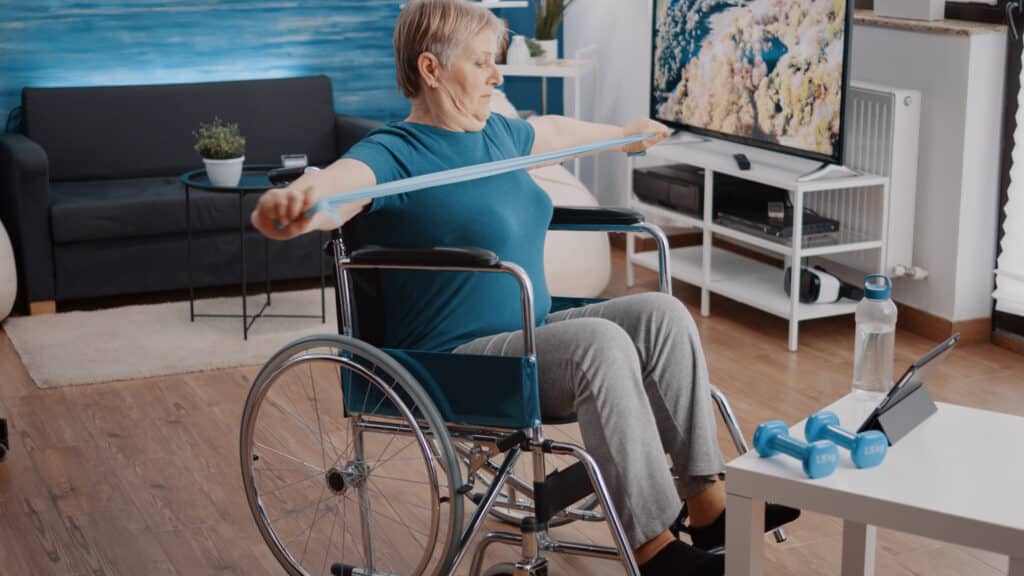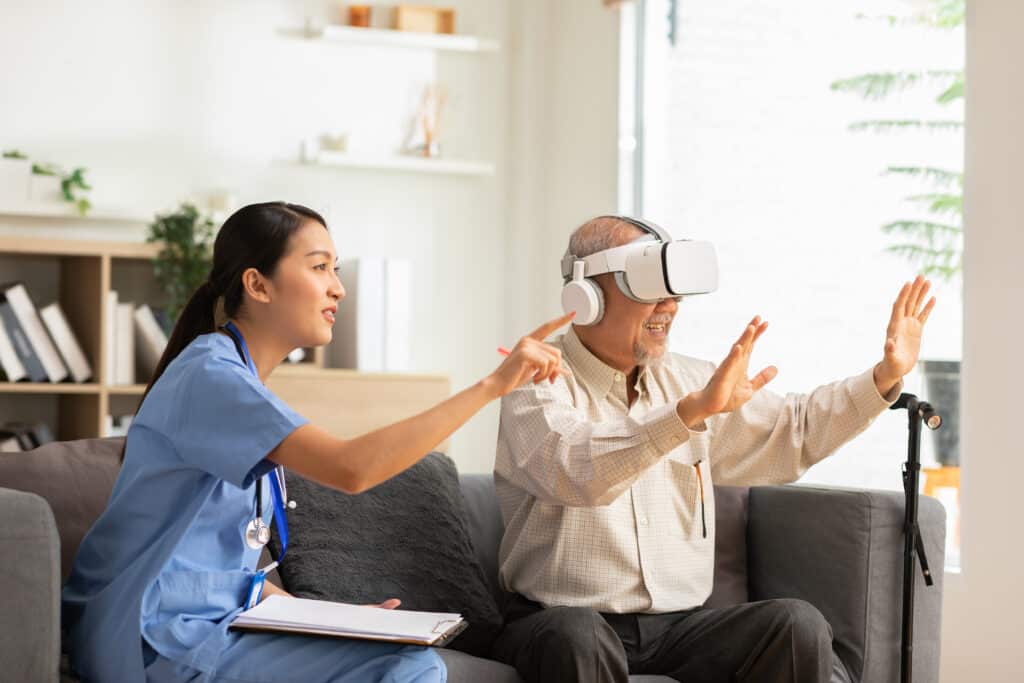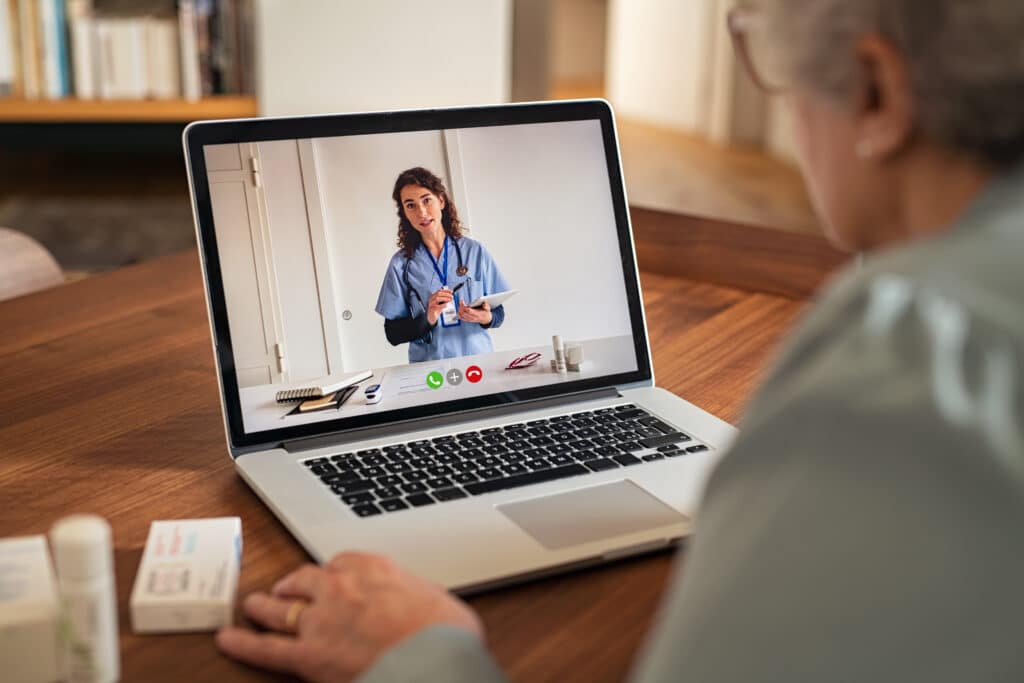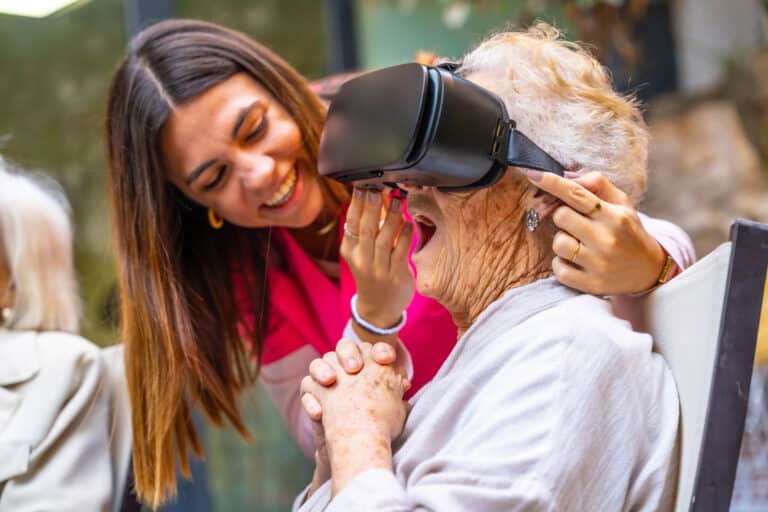The use of telerehabilitation—also known as telemedicine or telehealth—has changed the way physical therapy is delivered to adults of all ages and backgrounds.
Using video technology, telerehabilitation allows older adults to receive the care they need from the comfort of their own homes. It has become a valuable part of modern healthcare.
But what exactly is telerehabilitation in physical therapy, and why should you consider it?
Telerehabilitation can be invaluable for people who have trouble getting to a brick-and-mortar clinic, which can seriously impact their care. As a physical therapist, I’ve had the opportunity to use telerehabilitation with my patients to help them reach their goals more easily.
In this article, we’ll explore the benefits, challenges, and uses of telerehabilitation in physical therapy for older adults.
What is Telerehabilitation?

Telerehabilitation combines various technologies to offer physical therapy treatments remotely, increasing access to care and making it more flexible and convenient. This approach grew exponentially during the COVID-19 pandemic when in-person visits to the clinic were limited.
Physical therapists use tools such as video calls, wearable devices, and specialized apps to monitor your progress remotely and provide care in the comfort of your own home.1,2
Telerehabilitation sessions usually involve an assessment and guided activities, followed by progress tracking – all provided virtually. This allows your physical therapist to provide feedback and guidance as you perform rehabilitation exercises and adjust your treatment plan accordingly.
Having worked with patients both in person and via telerehabilitation, I consider it an excellent tool for helping people who otherwise wouldn’t be helped and improving communication with everyone else.
Another benefit is that you’re still seeing your physical therapist, so the care is personalized, just like it would be with in-person care.
What Conditions Can Be Treated With Telerehabilitation?

Like traditional PT, telerehabilitation can be used to treat a wide variety of conditions, including:
Musculoskeletal Conditions
Telerehabilitation can treat classic joint, muscle, and bone injuries.
Patients with conditions such as arthritis, back pain, or recovering from certain surgeries can perform prescribed physical therapy exercises at home while their therapist ensures proper form and monitors their progress over video calls.
Neurological Conditions
Conditions such as Parkinson’s disease, stroke, and multiple sclerosis can all benefit from telerehabilitation treatments.
Those living with conditions that require ongoing physical therapy, such as recovering from a stroke, can experience positive outcomes from performing exercises remotely to improve balance, coordination, and strength while still having the support of their therapist.3,4
Cardiorespiratory Conditions
Telerehabilitation can help patients with chronic obstructive pulmonary disease (COPD) or those recovering from a cardiac event achieve better respiratory function and overall fitness.
Physical therapists can design an exercise program for their patients that improves endurance, manages their symptoms, and provides real-time feedback and guidance.
In short, telerehabilitation can be used to treat many different health conditions, and its adaptability makes it a great way for physical therapists to provide real-time support and guidance for their patients to reach their rehabilitation goals.
Looking at some of the conditions we just mentioned, I think it’s very important to recognize that many of those patients might be unable to attend regular physical therapy appointments at a traditional clinic.
Providing new ways to access and engage in treatment is a major selling point of telerehabilitation, and it shouldn’t be ignored.
What Are the Benefits of Telerehabilitation?
Telerehabilitation is an exciting option for older adults and physical therapists alike. Here’s a few major reasons why:
Accessibility and Convenience
One of the biggest benefits of telerehabilitation is increased access to care. Patients in remote areas can access high-quality physical therapy services or specialty care services without traveling long distances.
Older adults struggling with mobility or who don’t have reliable transportation especially benefit from the increased accessibility of services.
Sometimes, a physical therapy session can be more of a quick “check-in” and progress update. Alternating appointments between in-person and virtual can be a more convenient option for these circumstances when manual interventions aren’t needed at every visit.
Telerehabilitation offers more flexibility in scheduling, too. Patients don’t have to take time off work or find childcare to attend appointments since they can arrange their sessions when it’s most convenient for them.
Cost-Effectiveness
Telerehabilitation can offer a more cost-effective treatment option for many patients. Eliminating the need to travel to appointments also eliminates travel costs associated with getting there.
Whether it’s by bus, taxi, or personal vehicle, transportation costs can be a barrier to care, especially for those with limited incomes or who live in very remote areas.
Studies have also suggested that telerehabilitation services can reduce overall healthcare costs.5
This reduction is due to decreased hospital visits and readmissions, travel expenses, and other logistical factors. Receiving care remotely allows patients to save money while continuing their rehabilitation in the comfort of their own homes.
Patient Engagement
By increasing convenience and enabling patients to receive care from home, it’s more likely that patients will show up for their appointments, engage, and stick to their treatment plans.
Using technology like apps and wearable devices is also a fun way for patients to keep track of their progress and stay motivated. This empowers them to take a more active role in their rehabilitation and enhances outcomes.
Early in the COVID-19 pandemic, many providers (myself included) were against the idea of telerehabilitation because they assumed it wouldn’t provide value to their patients.
More recently it has even been recognised by the American Physical Therapy Association who established a set of practice guidelines to regulate the use of telerehabilitation among the growing number of practitioners using it.5
Potential Limitations of Telerehabilitation

Though telerehabilitation offers many benefits, it’s not perfect. There are challenges and limitations that need to be addressed for it to be an effective treatment tool.6
Technological Barriers
Participating in telerehabilitation sessions requires a stable internet connection and a basic level of technical knowledge. This can be a big hurdle for older adults who may not be as comfortable using digital devices like computers or at-home wearable devices.
Another barrier to consider is poor internet connection and inadequate video quality, making it difficult to provide proper care. Reliance on technology is one of the primary challenges faced with telerehabilitation services.
Clinical Limitations
Physical therapists typically use a hands-on approach to assess, diagnose, and treat conditions. This can include initial testing to determine a treatment plan, assessing progress, performing assisted stretching, and providing manual treatments for muscles and joints.
The inability to perform these assessments in person means that physical therapists need to rely more heavily on self-reporting from their patients, which can be less accurate and make it difficult to identify concerns early on, limiting the efficacy of telerehabilitation for some conditions.
Similarly, for certain conditions, having a medical professional available for safety during exercise is necessary. For balance-challenged patients, telehealth may not be the best option.
Privacy and Security
Data breaches and unauthorized access to sensitive health information are significant concerns in telerehabilitation. Healthcare providers must follow strict regulations to protect patient data, and the transmission of this information over the Internet raises the risk of security breaches.
The Future of Telerehabilitation in Physical Therapy

Telerehabilitation has grown and become widely accepted in physical therapy. This shift to include virtual care has been driven by the need for more accessible remote healthcare options for patients of all ages.
Here’s what the future of telerehabilitation may look like:
APTA Adoption and Guidelines
New guidelines developed by the American Physical Therapy Association support the implementation of telerehabilitation services and provide recommendations on how clinicians can prepare, execute, and evaluate virtual services effectively.
This means that not only does your physical therapist probably support telerehabilitation, but so does the APTA, the largest regulatory body for PT in the United States.
Reimbursement Changes
The Expanded Telehealth Access Act has helped overcome some of the barriers related to insurance coverage and state regulations.
These recent changes have provided more opportunities for research and the use of telehealth in certain situations and have helped start a broader conversation around telerehabilitation.
Currently, many new laws and regulations are being developed to improve access to telerehabilitation and secure its future availability as an option for older adults.
New Technology
Telerehabilitation has been able to quickly transform and adapt to our needs with the help of new technology.
Artificial intelligence (AI) and machine learning can analyze data and offer treatment recommendations based on individual needs, while virtual reality (VR) and augmented reality (AR) are being explored as avenues to simulate real-world environments where you can practice exercises and activities.
For example, you can perform strength training exercises in a virtual gym or practice balancing exercises in a simulated park—all from your own home. I believe this will be a major game changer for the field of physical therapy in the coming years.
When all is said and done, telerehabilitation is just one of many tools to help older adults get the best physical therapy possible. However, it is evolving so quickly and being received so well that it may be here to stay, and it may change the way older adults get their physical therapy for good.
Key Takeaways
- Telerehabilitation uses video technology, wearable devices, and apps to bring physical therapy right into your living room.
- During the COVID-19 pandemic, it took off, offering a safe and convenient alternative to in-person visits.
- It’s a game-changer for older adults, those with mobility issues, and people living in remote areas.
- Telerehabilitation is effective for conditions like arthritis, back pain, Parkinson’s disease, stroke, multiple sclerosis, and COPD.
- It boosts accessibility and convenience by reducing the need for travel to appointments.
- Cost-effective, it cuts out travel expenses and can lower overall healthcare costs.
- Patients are more likely to attend sessions and stay committed to their treatment plans, thanks to engaging technology.
- Some challenges exist, like needing a stable internet connection and basic tech skills, which can be tricky for some older adults.
- The lack of physical contact can limit comprehensive assessments and certain treatments.
- Healthcare providers are increasingly embracing telerehabilitation, with guidelines now in place to support its use and regulation.
FAQs
What is telerehabilitation in physical therapy?
Telerehabilitation in physical therapy uses video technology, wearable devices, and specialized apps to provide remote physical therapy treatments, allowing patients to receive care from their own homes.
How does telerehabilitation benefit older adults?
Telerehabilitation is especially beneficial for older adults as it provides convenient access to physical therapy without the need for travel, making it easier for those with mobility issues or living in remote areas to receive consistent care.
Can telerehabilitation treat serious conditions effectively?
Yes, telerehabilitation can effectively treat a variety of serious conditions, such as arthritis, back pain, Parkinson’s disease, stroke, multiple sclerosis, and COPD, by enabling patients to perform prescribed exercises under the remote supervision of their therapists.
What are the technological requirements for telerehabilitation?
Patients need a stable internet connection and a basic level of technical skills to participate in telerehabilitation sessions. They will typically connect with their therapists through video calls, apps, and sometimes wearable devices.
Are there any limitations to telerehabilitation in physical therapy?
While telerehabilitation offers many benefits, it does have limitations, such as the inability to perform hands-on assessments and treatments. This can make it less effective for conditions that require manual interventions or close physical supervision.
How has the adoption of telerehabilitation changed the field of physical therapy?
The adoption of telerehabilitation has significantly expanded, especially during the COVID-19 pandemic. Healthcare providers have embraced it and supported it by guidelines from organizations like the American Physical Therapy Association, highlighting its effectiveness and integration into modern healthcare practices.
References
- Toh SFM, Gonzalez PC, Fong KNK. Usability of a wearable device for home-based upper limb telerehabilitation in persons with stroke: A mixed-methods study. Digit Health. 2023 Feb 7;9:20552076231153737. doi: 10.1177/20552076231153737. PMID: 36776407; PMCID: PMC9909064.
- Muñoz-Tomás MT, Burillo-Lafuente M, Vicente-Parra A, Sanz-Rubio MC, Suarez-Serrano C, Marcén-Román Y, Franco-Sierra MÁ. Telerehabilitation as a Therapeutic Exercise Tool versus Face-to-Face Physiotherapy: A Systematic Review. Int J Environ Res Public Health. 2023 Feb 28;20(5):4358. doi: 10.3390/ijerph20054358. PMID: 36901375; PMCID: PMC10002129.
- Truijen, S., Abdullahi, A., Bijsterbosch, D. et al. Effect of home-based virtual reality training and telerehabilitation on balance in individuals with Parkinson disease, multiple sclerosis, and stroke: a systematic review and meta-analysis. Neurol Sci 43, 2995–3006 (2022). https://doi.org/10.1007/s10072-021-05855-2
- Federico S, Cacciante L, Cieślik B, Turolla A, Agostini M, Kiper P, Picelli A on behalf of the RIN_TR_Group. Telerehabilitation for Neurological Motor Impairment: A Systematic Review and Meta-Analysis on Quality of Life, Satisfaction, and Acceptance in Stroke, Multiple Sclerosis, and Parkinson’s Disease. Journal of Clinical Medicine. 2024; 13(1):299. https://doi.org/10.3390/jcm13010299
- Alan C Lee, Judith E Deutsch, Lesley Holdsworth, Sandra L Kaplan, Heidi Kosakowski, Robert Latz, Lydia Lennox McNeary, Jennifer O’Neil, Oscar Ronzio, Kelly Sanders, Michelle Sigmund-Gaines, Michele Wiley, Trevor Russell, Telerehabilitation in Physical Therapist Practice: A Clinical Practice Guideline From the American Physical Therapy Association, Physical Therapy, Volume 104, Issue 5, May 2024, pzae045, https://doi.org/10.1093/ptj/pzae045
- Telehealth Can Save People with Cancer Time, Travel, and Money. National Cancer Institute.
- Munce S, Andreoli A, Bayley M, Guo M, Inness EL, Kua A, McIntyre M. Clinicians’ Experiences of Implementing a Telerehabilitation Toolkit During the COVID-19 Pandemic: Qualitative Descriptive Study. JMIR Rehabil Assist Technol. 2023 Mar 10;10:e44591. doi: 10.2196/44591. PMID: 36897634; PMCID: PMC10039414.






